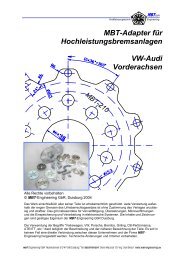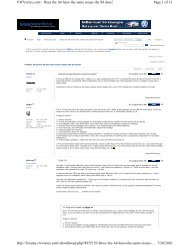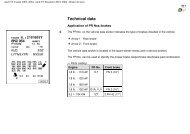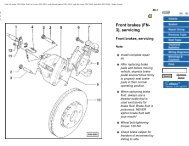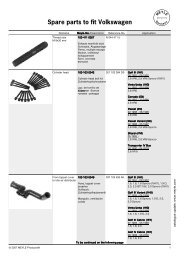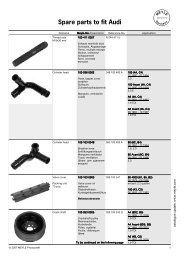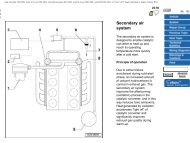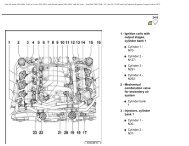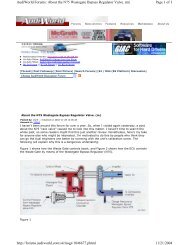VW MKII A2 MK2 Golf Jetta Fox Service Manual - VAGLinks.com
VW MKII A2 MK2 Golf Jetta Fox Service Manual - VAGLinks.com
VW MKII A2 MK2 Golf Jetta Fox Service Manual - VAGLinks.com
Create successful ePaper yourself
Turn your PDF publications into a flip-book with our unique Google optimized e-Paper software.
4C•4 Fuel and exhaust systems - K-Jetronic fuel injection - 16 valve engines<br />
3.1 Checking continuity of idling<br />
stabilisation control valve wiring<br />
8 Check that the mixture (CO reading) is as<br />
specified. Temporarily block off the exhaust<br />
tailpipe not fitted with the analyser probe<br />
while making the check. If necessary, turn the<br />
mixture screw as required after removing its<br />
cap. A special key is necessary in order to<br />
turn the screw but a suitable tool may be used<br />
as an alternative. Note that the screw must<br />
not be depressed or lifted and that the engine<br />
must not be revved with the tool in position.<br />
9 Refit the crankcase ventilation hose. If the<br />
CO reading increases, the engine oil is diluted<br />
with fuel and should be renewed.<br />
Alternatively, if an oil change is not due, a long<br />
fast drive will reduce the amount of fuel in the<br />
oil.<br />
10 Reconnect the wiring plug and remove the<br />
test instruments. Note that after reconnecting<br />
the wiring plug, the stabilisation system will<br />
return the idling to the specified speed.<br />
3 Idle speed stabilisation<br />
system - testing 3<br />
1 Check that the stabilisation control valve<br />
buzzes when the ignition is switched on. If<br />
not, use an ohmmeter to check the valve<br />
continuity after pulling off the connector (see<br />
illustration).<br />
2 Similarly, check the system temperature<br />
sender resistance at the following<br />
temperatures (see illustration):<br />
a) At 20°C - approximately 1000 ohms<br />
b) At 60°C - approximately 250 ohms<br />
c) At 100°C - approximately 75 ohms<br />
3.2 Checking temperature sender<br />
resistance<br />
3 If the system fault cannot be traced using<br />
the previous test then check all associated<br />
wiring. If necessary, renew the control unit<br />
which is located behind the centre console.<br />
4 The operations of the control valve may be<br />
checked by connecting a multi-meter to it.<br />
With a tachometer connected, run the engine<br />
(hot) at idle speed and note the control<br />
current. Now pinch the hose shown (see<br />
illustration) and check that the current rises.<br />
Release the hose, increase the engine speed<br />
to 1300 rpm and actuate the throttle valve<br />
switch. The control current should drop below<br />
430 mA. With the wiring disconnected as<br />
described in paragraph 6, Section 2, the<br />
control current should be constant between<br />
415 and 445 mA.<br />
4 Overrun cut-off valve -<br />
testing 2<br />
1 With a tachometer connected, run the<br />
engine (hot) at 2500 rpm. Operate the throttle<br />
valve switch and check that the engine hunts<br />
(ie. its speed fluctuates). If not, let the engine<br />
idle, disconnect the valve wiring and connect<br />
a voltmeter to the terminals as shown (see<br />
illustration). Zero volts should be registered.<br />
2 Increase the engine speed to 4000 rpm,<br />
then quickly close the throttle. At 1400 rpm,<br />
battery voltage should be indicated.<br />
3 If necessary, renew the control unit which is<br />
located behind the centre console.<br />
4.1 Checking overrun cut-off valve (1) 5.1 Checking diaphragm pressure switch<br />
1081 <strong>VW</strong> <strong>Golf</strong> & <strong>Jetta</strong><br />
3.4 Checking idle stabilisation valve by<br />
pinching hose (arrowed)<br />
5 Diaphragm pressure switch -<br />
testing 2<br />
Pull the wiring connector from the switch,<br />
then connect an ohmmeter to the switch<br />
terminals (see illustration).<br />
With the engine idling, the reading should<br />
be infinity. Quickly open and close the throttle<br />
and check that the resistance drops briefly<br />
then rises to infinity.<br />
6 Throttle valve switch - testing<br />
2<br />
1 Pull the wiring connector from the throttle<br />
valve switch.<br />
2 Using an ohmmeter, check that with the<br />
throttle closed there is zero resistance<br />
between terminals 1 and 2 but a reading of<br />
infinity between terminals 2 and 3. With the<br />
throttle open, the readings should be reversed<br />
(see illustration).<br />
3 To adjust the switch, insert a 0.10 mm feeler<br />
blade between the throttle lever and stop (see<br />
illustration), then loosen the screws and move<br />
the switch towards the lever until the contacts<br />
are heard to click. Tighten the screws on<br />
<strong>com</strong>pletion and remove the feeler blade.<br />
6.2 Throttle valve switch connector<br />
terminals<br />
See text for terminal identification



